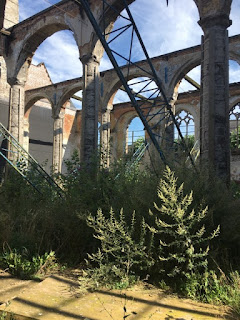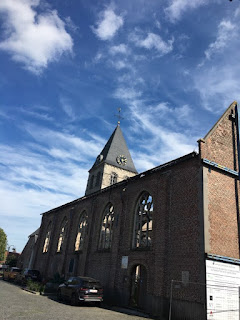BELGIUM Avelgem
“Prepare a good pair of walking shoes and brace yourself with that bad knee of yours, Raymond. We’re heading to Brussels,” Mario warned. I recalled Bro Vic’s advice: “Just be ready for long walks. Wear comfortable shoes as rides are rare and taxis are expensive.”
The journey from Mario’s farmhouse to Brussels took over an hour on the expressway. Speaking of driving, I once joked with Mario, who teasingly offered me the steering wheels, that I’d struggle to drive his SUV due to their unique driving etiquette.
Here, cars slow down and stop before the pedestrian crossings, allowing people to cross before proceeding, even in the absence of the traffic lights. I frequently witnessed drivers yielding to one another at intersections. On one occasion, Mario patiently followed two elderly cyclists down a long stretch of a narrow, single-lane road, devoid of a dedicated bike lane, without once honking – an uncommon display of courtesy.
Mario’s daughter Lisa and her fiancée, Thomas, both corporate professionals, were our guides for our tour of Brussels.
The Heart of Europe
Standing at the center of Brussels, the magnificent Grand Place, we were enveloped by a scene that felt like a living postcard. The ornate facades of the guildhalls, with their golden details gleaming in the sunlight, rose majestically around us, each telling a story of a bygone era. The town Hall’s spire reached toward the sky, a beacon of history watching over the square.
Tourists from all corners of the globe ambled across the cobblestones, their cameras capturing the grandeur of the square. I got an earful of a blend of languages, merging into a harmonious buzz.
“Filipina ka?” I overheard someone say. It was a voice from a company of three, asking Merlita, who replied, “Oo, Filipina, pero Bisaya.” A quick chat followed with those Tagalogs who drove from Amsterdam. Then they split all at once vanishing into the crowd.
A street trumpeter played, adding a touch of romance to the air, while laughter from nearby café terraces filled the space, mingling with the rich aroma of freshly brewed coffee and the sweet scent of waffles.
At a nearby table, a group of friends clinked glasses of amber-hued Belgian beer, their conversation lively and full of warmth. Not far away, a couple paused to admire a chocolatier’s window, where pralines (sugary, nutty candies) were displayed like precious jewels, each a small work of art.
Flower Carpet
Cher and I struck poses as Mario captured strategic shots of us with his Samsung cellphone, set against the stunning 70-meter-long by 24-meter-wide expanse of begonias, dahlias, grass, and bark. This vibrant tapestry had been meticulously assembled by a hundred volunteers in under six hours, marking the 3-4 day celebration of the Brussels Flower Carpet that has graced the city every two years.
Atomium
Our group drove to the most prominent tourist attraction that symbolizes Brussels – the Atomium. Originally, built for the 1958 Brussels World’s Fair (Expo 58), it has represented not just Brussels, but also Belgium’s forward-looking spirit and its embrace of modernity.
Its nine interconnected spheres and towering height of 102 meters, have represented an iron crystal magnified 165 billion times. A striking blend of art, architecture, and science, it has symbolized Brussels’ role as a hub of international cooperation, progress, and unity – values that have been central to Brussels’ identity as the heart of Europe.
Ruined Church
As we drove home, wandering through the picturesque towns of Belgium, we caught sight of a striking scene – a dilapidated Catholic church. Its once-majestic walls stood bare, stripped of their roof, open to the sky like a hollow shell of its former self. Weeds crept through the cracks in the stone, and the wind whispered through the broken windows, carrying with it an eerie silence that spoke volumes. This scene, both sad and haunting, felt like more than just the inevitable decay of an old building; it felt like a powerful symbol, a poignant reflection of the broader secularization sweeping across not only Belgium but much of the Western world.
The crumbling church, with its empty pews, has encapsulated the challenges facing Christendom today. It has stood as a silent witness to the decline in religious attendance that has marked much of the past century. In a land where church bells once called the faithful to worship every Sunday, such calls often have gone unanswered. The congregation that once filled this church, with prayers and hymns reverberating off its walls, has dwindled, leaving behind only echoes of a past era.
Cultural Shifts
This decline is not merely a matter of changing habits but reflects deeper cultural shifts. Belgium, like much of Western Europe, has embraced modernization with open arms, and with it has come a gradual shift away from traditional religious practices. As society has advanced, with increased education, technological innovation, and a focus on individual autonomy, the role of the church has become less central in the daily lives of many. The once-dominant influence of the church on public and private life has been replaced by secular values and institutions that better align with the complexities of the modern world.
I found myself drawn to two images that seemed to embody the contrasting spirits of Belgium: the Atomium, a gleaming monument of modernity, and a dilapidated church, standing quietly as a relic of a bygone era.
The Atomium has reflected the secularization of Belgium. It has stood as a monument to a new kind of faith – faith in human progress, in reason, and in the power of collective effort to shape the world. Yet in the shadow of this gleaming structure, an image has lingered – a dilapidated church, its roof caved in, its walls crumbling.
I was struck by the contrast: where the Atomium was bold and triumphant, the church was quiet, almost forlorn. Once, the church would have been the heart of its community, a place of worship, solace, and gathering. Now, it has stood as a poignant reminder of what has been lost in the march toward modernity.
Call To Renewal
Perhaps, this ruined church is not just a symbol of decline but also a call to renewal. It challenges us to consider what we, as a society, have lost in the process of secularization, and what we might need to reclaim – not necessarily in the form of a return to the past, but in finding new ways to connect with the spiritual, the sacred, and the communal aspects of life that religion once nurtured. It invites us to think about how the church, or any institution that seeks to guide and inspire, can evolve to meet the needs of a changing world without losing its essence.
As we left the ruined church behind, with the image of Atomium still flashing in my mind, I felt a deep sense of sadness. Belgium, like much of the world, has stood at a crossroads, where the old and the new must find ways to coexist.
The challenge, I discerned, is not to choose between the two, but to create a future where the brilliance of modernity can shine alongside the quiet wisdom of the past – a future where both the Atomium and the Church, in all their contrasting glory, can stand as testaments to the rich and complex tapestry of human experience.










No comments:
Post a Comment